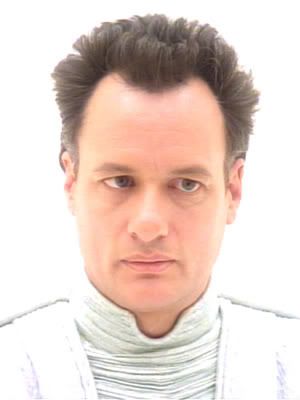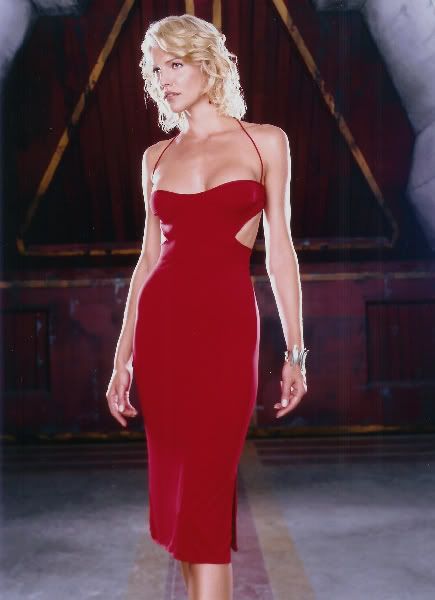
[audio:http://www.blueinkalchemy.com/uploads/bsg.mp3]
In recent years, for one reason or another, many stories in speculative fiction have been ‘rebooted’. In most cases the ‘new’ versions of the stories have suffered from either not being very well executed, getting called out for disregarding the established histories and characterizations of the source material or both. Transformers, Star Wars and Flash Gordon appear to be the biggest offenders. It’s rare for a reboot or re-imagining to get the aforementioned sticking points right, or for a science fiction TV series to have a strong start. 2004’s Battlestar Galactica does both, and it began with a mini-series that is the subject of today’s review. The series stars Edward James Olmos, Mary McDonnell, Jamie Bamber, James Callis, Katee Sackhoff, Tricia Helfer, Grace Park, Michael Hogan, Tahmoh Penikett and Alessandro Juliani.
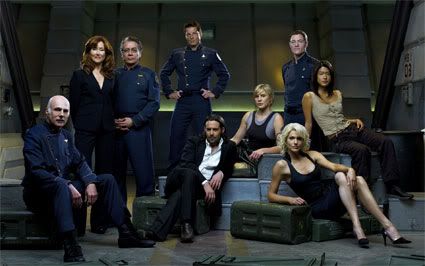
As far as the characters go, to keep track of who’s frakin’ who, you might need a flowchart.
Battlestar Galactica originally aired back in 1978 and was ambitious for its time. Despite being accused of ripping off Star Wars, the series seemed more interested in borrowing the ‘Wagon Train to the stars’ notion from Star Trek. The million dollar budgets the show required per episode and the slowly declining quality of the stories – within the show’s only season – both contributed to its cancellation in 1979. The coffin seemed nailed pretty securely shut with Galactica 1980, a spin-off so bad some Galactica fans don’t even acknowledge its existence. Creator Glen A. Larson would recycle the look & feel of the show for Buck Rodgers in the 25th Century, but as far as Galactica was concerned, it seemed the journey had ended once and for all, until more than two decades after the last episode aired.
Ronald D. Moore, veteran writer & producer for Star Trek series The Next Generation and Deep Space Nine, was approached by David Eick, who was having a little trouble getting a reboot of Battlestar Galactica off the ground. Ideas to restart or continue Galactica‘s story had been pitched by Tom DeSanto, Bryan Singer, and original series star Richard Hatch, but nothing had stuck. Ron & David not only constructed a mini-series that could stand on its own but could also serve as the launching point for a series on what was then called the Sci-Fi Channel, back before they re-branded themselves to gather more hits on Google since that’s what telling science fiction stories is all about. Anyway, the result of this reboot aired in 2004, and the response was overwhelming.
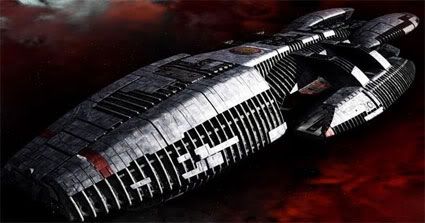
Arguably the most badass museum piece in the known galaxy.
Among the Twelve Colonies of Kobol, the Cylons were created by man as servants and laborers. Eventually, they got a little sick and tired of shoveling coal and giving massages, so they took up arms against their creators. The war was bloody, and ended in a draw. The Cylons left to make their own way on worlds far from the colonies, and a space station was established for communication purposes. 40 years have passed since the armistice, and the Galactica, one of the oldest battlestars remaining in the Colonial fleet, is due for retirement as a museum. Her commander, William Adama (Edward James Olmos), is also something of a relic, wary of computer networks and maintaining discipline aboard his ship despite its age and somewhat antiquated design.
His paranoia’s somewhat justified, though, as the Cylons have evolved and can masquerade as humans. One of the humanoid models, Number Six (Tricia Helfer), has managed to infect the Colonial defense network thanks to her relationship with resident genius Gaius Baltar (James Callis). Baltar, rather than being a cartoonish malevolent hand-wringing mustache-twirling villain as he was in the 70s is, here, an unwitting dupe in the Cylon plan to eradicate mankind in a surprise nuclear attack. When the attack happens, there’s no warning and absolutely nobody is prepared. The Cylons not only nuke the hell out of all 12 colonies, they hack the networked systems of the Colonial warships, from the mighty battlestars to the Viper fightercraft. Only one ship is immune to this form of attack, and Galactica becomes the shepherd of a fugitive fleet containing the remnants of the human race, on the run from their would-be exterminators and held together by the hope that the mythical 13th colony exists out in the darkness of unexplored space – a colony known as Earth.
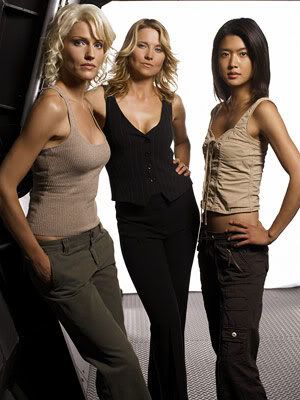
Three hotter toasters you would be hard-pressed to find.
Overall, the mini-series was praised, and rightly so, for smart writing, good direction, multi-dimensional characters that gain our loyalty and sympathy relatively quickly, Bear McCreary’s haunting music and revitalizing an old premise in a new and interesting way. Any one of these aspects of the show is worthy of a full review in and of itself, so suffice it to say that all of them work together to create an experience that is, on the whole, absolutely astounding. It wasn’t without its detractors, however, most of whom said that this new vision of an old favorite had completely destroyed anything that had come before and was a travesty unworthy of the name of their beloved franchise. Wait. Does that seem familiar at all to anybody else? Gee, I wonder where I’ve heard that before…
In any event, Battlestar Galactica is well worth the watching. The mini-series is the logical place to begin, and while it runs longer than most feature films, the time is not idly spent. Pick it up from Netflix, or Best Buy, or any place to you can pick it up – it’s definitely worth it. The series that follows is good on the whole, with some missteps here and there. I’ve been accused of universally loving this series and every single episode of it, but that really isn’t the case. Like all science fiction television series, it has episodes ranging from the very good to the very bad. I’ve played with the idea of doing episode reviews in the great tradition of sfdebris or Confused Matthew, but I wouldn’t want to waste everybody’s time.
Josh Loomis can’t always make it to the local megaplex, and thus must turn to alternative forms of cinematic entertainment. There might not be overpriced soda pop & over-buttered popcorn, and it’s unclear if this week’s film came in the mail or was delivered via the dark & mysterious tubes of the Internet. Only one thing is certain… IT CAME FROM NETFLIX.


